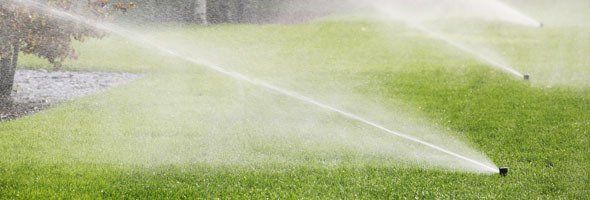3rd Generation
Family Owned & Operated
Serving Northern New Jersey

Get your landscaping facts straight!
You would be surprised how many people have been treating their property and mowing their lawns incorrectly. Here at Emerald Lawn-Scapes, we want to equip you with some common knowledge and some tips you may not know. After reading below, you should be able to better maintain your lawns, trees, and shrubs alike.
Watering
While watering is NOT Manditory when using Emerald Lawns Organic-Based Program, At certain times of the season watering does help. Your lawn typically needs about 1″-1 ½ ” of water per week. Lawns that are dry, are more stressed and more likely to sustain damage when not protected with an annual lawn care program. Rain is obviously our first source of water… So how do you know how much rain you’re getting each week?
Pick up a rain gauge at your local hardware store. If you measure an inch+ of rainfall per week, you’re cool. If you don’t, you need to water.
Watering an inch
How long should you water to get one inch?
That is a site specific question. It depends on several factors like:
What kind of irrigation system/heads you have? (Hose Sprinkler vs Misting vs Pulsating)
What is your water pressure?
You can find this out by getting several containers of some sort and measuring off ½” & 1” marks from the bottom of the containers. Run your sprinkler and see how long it takes to get a half inch of water in the containers… just like a rain gauge.
Typically, it’s about 20-30 minutes. So “if” 20 minutes, 3 times per week will give you an inch of water on your lawn, then 30 minutes 3 times per week will give 1 ½” of water. Bear in mind that during extreme heat, you will need to water more, due to evaporation and heat stress on the grass.
Don’t water daily
Watering daily is a no-no! This creates a shallow root system which causes your lawn to dry out faster and weaken your turf. You are also required to restrict watering during extended drought conditions. Depending on your house number, water or set your irrigation system to matching odd or even days..
Water for longer periods of time, less frequently! 3 times per week is a good start to help grow your grass roots deeper into the soil, making it stronger and more drought-resistant.
Watering in the morning
Watering early in the morning will ensure that your lawn dries completely before nightfall. A wet lawn at night, on a regular basis, can lead to fungus problems. Also, it’s cooler and less windy in the morning, so you have less evaporation, which will save money on your water bill and take less time to get the needed water into your lawn. If morning watering is impossible, watering at any time is always better than not watering at all!
The screwdriver test
If you can’t push a 6” screwdriver into your lawn, you’re not watering enough. Watering 1″-1 ½ ” per week is a guideline. Different soil types need different amounts. Soil is rarely composed of one type, but rather a combination of clay and sand, which makes loam. A sandy loam will not hold moisture as well as a clayish-loam. Clay holds moisture better (think mud,) but the water is slow to penetrate it. You can tell what your dominant type of soil is by getting a moist handful and squeezing it. Clay will smush into a ball that doesn’t fall apart. Sand will stick together when squeezed, but not for very long. High winds can also dry out your lawn incredibly fast.
Watering in the heat
If you want your lawn to look green and lush all season and not go dormant in the heat, you will need to water more during the summer months. You may need to water more in the summer heat to keep your lawn from becoming drought-stressed. If we have extreme temperatures – high 90’s and over 100º – for a prolonged time period, you may also want to skip a mowing! Grass only stores water in the green leaf (not in the roots) so the shorter the grass is the less water it holds to survive.
Grass also needs more water during the heat because it uses water as an internal coolant.
Water wisely
Don’t water so long that it runs down the street. If water starts running down the street before you get your half inch on there, turn off the water and wait for it to soak in, then resume watering. This might happen if you haven’t had time to water for a while. If it happens every time you water, either you’re waiting too long in-between watering’s, or you may have a compaction problem. Compaction occurs in heavy clay soil or in high traffic areas. Aeration will help alleviate that problem temporarily, but usually you have to change the conditions causing the compaction for long-term relief.
Checking your sprinklers
If you have automatic sprinklers, check them regularly to be sure you’re getting complete coverage. Have you ever driven by a neighborhood entrance or along a business with nice landscaping that has this one sprinkler head aimed out at the street, and every day it’s on, spraying in the street, even if it’s raining. Watch your sprinklers every once in a while to be sure you don’t have one out of adjustment!
Brown areas
If a brown area doesn’t respond to watering, look for another problem. Assuming your sprinkler coverage is adequate, you might have a fungus, Spring Dead Spot, chinch bugs, construction debris buried under the soil, or any number of problems that mimic drought stress. Take a closer look, or call us to come out and look at it.
Cutting heights
Mowing Height is the most important parameter of mowing for those of you that golf, consider your lawn the “rough,” not the Putting Green! It NEEDS to be mowed at 3” or Higher!
Why mow high?
When you mow at 2 inches, you will have 2 inches of roots. When you mow at 4 inches, you will have 4 inches of roots. The height of the grass drives the depth of the roots. A deeper root system means a greater ability to capture available water in the soil and survive hot, dry summers better.
Grass manufactures its sugars for survival through photosynthesis in the leaves of the plant. By mowing short you reduce or stop this processes. In northern zones with winter weather, cool season grasses such as Bluegrass, Fescue and Ryegrass should be mowed between 3 to 4 inches.
Mowing high creates a deeper root system that will help your lawn:
- Be more resilient to foot traffic through the summer months.
- Stay thicker & greener longer though the summer months
- Be more heat & drought resistant, recovering faster from the hot summer months!
- Be more disease resistant, reducing the need for expensive fungicide applications!
Acting as its own organic weed control, the taller grass will shade the soil surface, reducing weed germination (like Broadleaf and Crabgrass) and reducing herbicide applications!
Mowing higher will not require you to mow more frequently. Grass grows at the same speed between 1”-6”. After 6”, it actually slows down in growth. If you follow the much quoted “1/3rd rule”, you would mow when the grass is no higher than 3 inches to have a finished mow height of 2 inches (that’s too short). To have a finished mowing height of 3 inches (much better), you would mow when the grass is no taller than 4 1/2 inches.
Mowing dry vs. wet
Preferably Turfgrass should be mowed when it is dry. Wet grass is more difficult to cut and has the tendency to clog under rotary mower leaving clumps of grass clippings that (if left on lawn) will burn holes in turf allowing for weeds and fungus to develop. Mowing should not, however, be delayed for long periods of time because the grass is wet. If extended wet periods prevent timely mowing and the turfgrass gets excessively tall, move the mower height adjustment to the highest setting and mow the lawn. Once the wet period ends, lower the height adjustment to the desired height and resume regular mowing, alternating direction of previous mowing.
How to mow shady areas?
The more shade on an area of lawn, the LESS you should mow that area! Skip mowings in shady areas and Mowing at the highest possible setting will help create a Healthier, Thicker lawn.
Mowing Higher will encourage deeper root systems and Infrequent Mowing (Every other week) will help maintain a thicker, healthier lawn through the summer months reducing reseeding in the fall & incidence of disease.
How often should I mow?
Your lawn should be mowed once a week, roughly removing no more than 1/3 of the leaf blade length during any one mowing. While mulching you lawn does have great benefits, It should only be done when lawns are not growing vigorously. Mulching when the lawn is growing vigorously causing too heavy of clipping to lay on the lawn, resulting in clumps, burn holes, and eventual bare spots. Contrary to popular belief, turfgrass clippings do not contribute to thatch accumulation if proper mowing practices are followed.
Which mowing direction works?
The direction of mowing should be altered every one to two mowings. Mowing at right angles (90 degrees) to the previous direction will help prevent the grass from repeatedly being pushed in one direction and laying over, an important consideration at high mowing heights. Also if scalping of the lawn is a problem, the different mowing directions may help minimize continual scalping in any one area.
Mower maintenance
All mowing equipment should be kept in good working condition. Having the mower serviced prior to the heavy spring mowing period will help ensure regular, maintenance-free mowing. Mower blades should be sharpened EVERY spring. A dull mower blades will fray the ends of grass blades, causing a whitish look to the lawn, make the lawn more susceptible to fungus problems and lose more water than if cut by a sharp mower blade.
Mowing during a drought
Do not mow turfgrass suffering from extreme drought stresses. Grass suffering from lack of water should be watered deeply and then mowed after the leaf blades have dried off. Cut at the highest allowable height, This increases the leaf area and photosynthesis which results in more carbohydrates for plant growth. It also encourages a deeper root system.
The one exception
There is one exception to Mowing High: The First & Last Mowing of the Season!
- In areas that get snow cover, you should lower your blade height. Drop your mower height the last mowing, to about 2 inches tall going into the winter months. This will reduce possible disease issues during the winter since longer grass is more likely to harbor disease when covered with snow until spring.
- Then mow your lawn again at 2” for the first mowing of the Spring to help remove winter damage. Then raise your mower all the way up to 3 1/2 inches or Highest Setting for the rest of the Season.
We are licensed and insured for your protection
Contact us now
for our current
seasonal promotions!
Contact Us
We will get back to you as soon as possible
Please try again later


